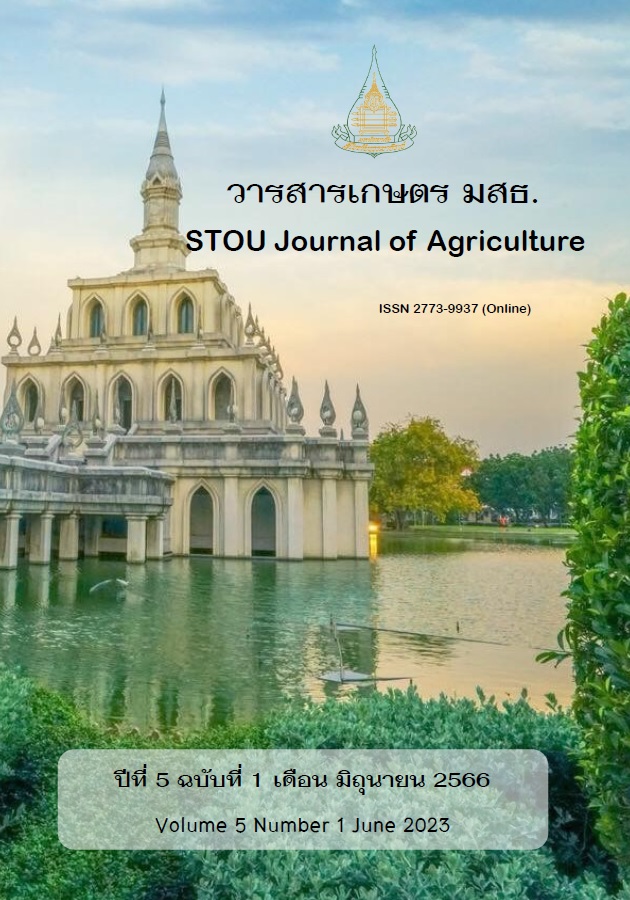Communication for Agricultural Extension and Sustainable Development
Main Article Content
Abstract
This article aims to explain communication for agricultural extension and sustainable development in three dimensions from the study found that 1) communication is an important tool in providing new perspectives and knowledge on economic growth in the agricultural sector, by using communication to drive the concept of the BCG Model to achieve of the economic sustainability indicators in 3 areas including Bioeconomy, Circular Economy, and Green Economy. 2) Communication is an essential tool in building a learning society, which emphasizes communication to foster cooperation, peace, and the inheritance of valuable wisdom that can lead to a quality agricultural society and sustainability. And 3) communication is an important tool to change the paradigm of natural resource use that places importance on participatory conservation and restoration of the environment. This will lead to joint responsibility for the sustainable management of agricultural resources. Therefore, communication for sustainable agricultural extension and development will focus on communication methods for creating links and maintaining balance among three dimensions: economy, society, and environment.
Article Details

This work is licensed under a Creative Commons Attribution-NonCommercial-NoDerivatives 4.0 International License.
บทความที่ได้รับการตีพิมพ์เป็นลิขสิทธฺ์ของวารสารเกษตร มสธ.
ข้อความที่ปรากฎใน
References
กระทรวงการอุดมศึกษา วิทยาศาสตร์ วิจัยและนวัตกรรม. (2564). แผนปฏิบัติการด้านการขับเคลื่อนการพัฒนาประเทศไทยด้วยโมเดลเศรษฐกิจ BCG พ.ศ. 2564-2570. (PDF). เข้าถึงได้จาก https://waa.inter.nstda.or.th/stks/pub/bcg/ 20211228-BCG-Action-Plan-2564-2570.pdf
แผนพัฒนาเศรษฐกิจและสังคมแห่งชาติ ฉบับที่ 13 (พ.ศ.2566-2570). (2566, 1 พฤศจิกายน). ราชกิจจานุเบกษา. เล่ม 139 ตอนพิเศษ 258 ง
มุกดา สุขสมาน. (2551). ชีวิตกับสภาพแวดล้อม. กรุงเทพฯ: อินโฟพริ้นติ้งเฮาส์.
อมร เพ็ชรสว่าง. (2564). เอลนีโญ ลานีญา ปรากฏการณ์ที่มีอิทธิพลต่อสภาพภูมิอากาศของโลก. (ออนไลน์). เข้าถึงได้จาก http://www2.gistda.or.th/main/en/node/4758
Aksakal Bunyamin and Kazu Ibrahim Yasar. (2015). Comparison of Adult Education Policies in Turkey and European Union. The Journal of Procedia - Social and Behavioral Sciences, 177, 235 – 239.
Alba Kruja. (2013). Sustainable Economic Development, a Necessity of the 21st Century: Mediterranean Journal of Social Sciences, 4(10), 93-98.
Alexis Kokkos. (2015). The Challenges of Adult Education in the Modern World. The Journal of Procedia - Social and Behavioral Sciences. 180, pp. 19 – 24.
Asabe I. Galadima. (2014). The Role of Adult Education in National Development. The Journal of International Letters of Social and Humanistic Sciences. 32, pp. 35 – 42.
Brundtland, G. (1987). Report of the World Commission on Environment and Development: Our Common Future. United Nations General Assembly Document A/42/427.
Cherdpong Kheerajit and Alexander G. Flor. (2013). Participatory Development Communication for Natural Resources Management in Ratchaburi Province, Thailand. Social and Behavioral Sciences, 103, 703–709
Dumitrescu, Iliana. (2014). Adult Education, Priority in Educational Policy of Spiru Haret. The Journal of Procedia - Social and Behavioral Sciences. 142, pp. 339 – 345.
Food and Agriculture Organization of the United Nations. (2011). The Communication for Sustainable Development Initiative (CSDI): Communication Efforts for Collaborative Change. Office of Knowledge Exchange, Research and Extension (OEK) Research and Extension Branch (OEKR).
Ismaila Yunusa Ilua and Fatai Olawalea. (2014.The Cogency of Melkote’s ‘Another Development’ for Development Communication in the Third World: The International Conference on Communication and Media 2014 (i-COME’14), 18-20 October 2014, Langkawi, MALAYSIA.
Leagans, J. P. (1961). Extension Education for Community Development. In: Kamath, M. G. (Ed). Extension Education in Community Development. India. Glasgow Printing Co. Pp 1–26.
Maria Claudia Cuc. (2014). Development of a communication system for capitalizing cultural diversity. Babeş-Bolyai University, Faculty Psychology and Sciences of Education, Romania.
Melkote, S. (2001). Analysis of Melkote’s 2001 Communication for Development in the Third World: Theory and Practice for Empowerment.
Nilsen, T. R. (1957). Interpretive function of the critic. Western Speech, 21, 70-76.
Rogers, E.M. (2003). Diffusion of innovations (5th ed.). New York: Free Press.
Roger, Everett M. and Lynne Svenning. (1969). Modernisation among Peasants. New York: Holt, Rinehart and Winston.
Sanoff, Henry. Participatory Design; Theory & Techniques. Raleigh, NC: Bookmasters, 1990. Print.
Segal, J., Smith, M., Segal, R., & Robinson, L. (2019). Stress Symptoms, Signs, and Causes. HelpGuideorg International. Retrieved from: https://www.helpguide.org/articles/stress/stress-symptoms-signs-andcauses.htm.
Waisbord, S. (2014). The Strategic Politics of Participatory Communication. The Handbook of Development Communication and Social Change, 145-167.


